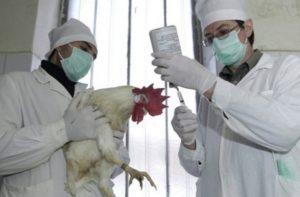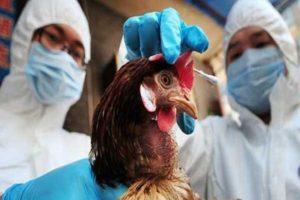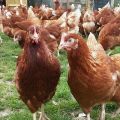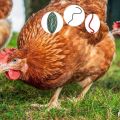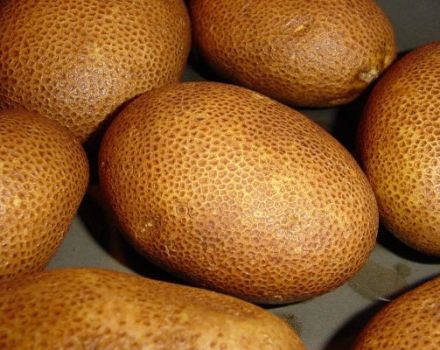Causes, symptoms and treatment of diseases of laying hens at home
A large number of diseases of laying hens are known at home. They all fall into several broad categories. Pathologies are infectious, parasitic, non-infectious. Each of the groups has a characteristic clinical picture and differs in provoking factors. To cope with the disease, it is necessary to make a correct diagnosis. Carrying out preventive measures is of no small importance.
Classification of diseases
In veterinary practice, several categories of avian diseases are distinguished:
- Infectious - these pathologies are caused by infection with pathogenic pathogens, among which there are viruses and bacteria. These disorders are characterized by a high level of contagiousness. As a consequence, there is the possibility of outbreaks of infections that can lead to dangerous consequences. This group also includes diseases that are dangerous to humans.
- Parasitic - these pathologies occur in chickens after various invasions by parasites. Worms, feather eaters, and ticks lead to their development. These diseases are also classified as contagious. They are rapidly spreading among chickens.
- Non-contagious - diseases from this group arise due to the wrong choice of diet. Violation of sanitary conditions in the poultry house also leads to them. In this case, episodic lesions of individuals are observed. These diseases do not pose a threat to the rest of the herd.
Infectious diseases
Such pathologies appear when feathered pathogenic microorganisms enter the body. Viruses, bacteria, fungi become the causes of diseases. The spread of infection occurs through water, food, waste.
Laryngotracheitis
This virus primarily affects the respiratory system of chickens. At the same time, birds develop a persistent cough with mucous and bloody impurities, inflammatory lesions of the larynx, respiratory failure, conjunctivitis. There is also a risk of wheezing in the lungs and impaired laying.
In almost all situations, death is due to suffocation. There are no effective ways to eliminate the disease. To avoid complications, antibiotics are used.
Gumboro disease
This pathology is not characterized by obvious manifestations.It is most commonly found in chicks less than 5 months old. In this case, there is an inflammatory lesion of the lymphatic system and the bursa. Hemorrhage also occurs in the stomach and pecking of the cloaca.
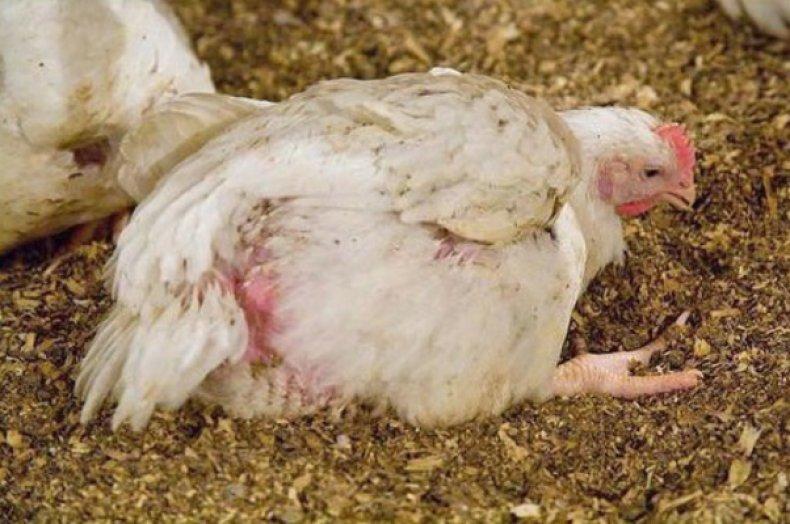
The lethal outcome occurs on day 4. There are no effective treatments. Disposal of individuals must be carried out in a special place.
Bird flu
This disease affects the entire herd. In this case, all individuals die. There are no effective medicines. Symptoms of this viral infection include blue scallops and earrings, diarrhea, fever, and lethargy. Also, birds become drowsy, they have a deterioration in respiratory functions and wheezing. A viral infection can mutate and infect people.
Newcastle disease
The infection is spread by airborne droplets. Infection can be carried out through droppings, water, feed. In this case, all organs are affected. Symptoms include croaking sounds, impaired appetite, and impaired swallowing. At the same time, mucus accumulates in the bird's beak and nose.
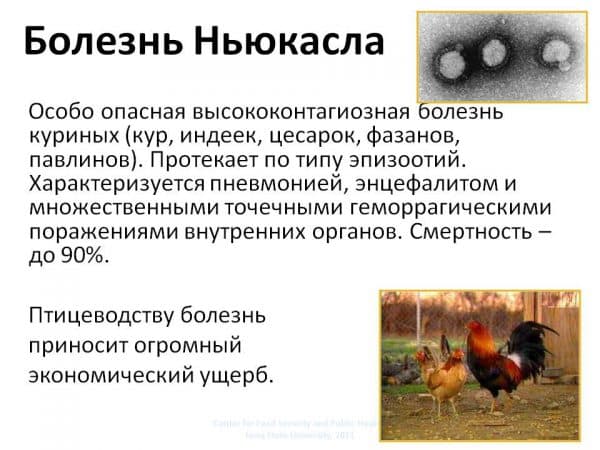
As the pathology progresses, the chickens begin to run in a circle, their scallop turns blue. Then the birds die. They need to be burned or sprinkled with lime. Acute forms of pathology can be transmitted to people. There are no effective treatments. In 3 days, the livestock dies.
Smallpox
This virus is spread by sick birds, parasites, rodents. Blood-sucking insects can also be a source of infection. At the same time, the skin of the birds is covered with red rashes that resemble warts. After some time, they acquire a yellow-gray color. In this case, the mucous membranes of the oral cavity are covered with a white bloom. The disease is accompanied by damage to the eyes and internal organs. Infected chickens have trouble swallowing. They develop weakness and an unpleasant odor from the respiratory system.
Treatment should be started immediately when pathology is detected. In the later stages, infected birds must be destroyed. To eliminate the disease, skin treatment with furacilin is used. Chickens need to be given tetracyclines inside.
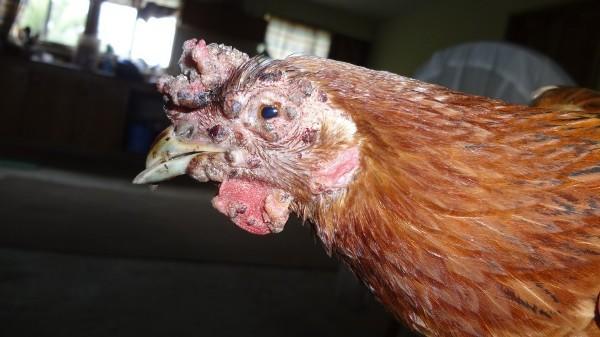
Mycoplasmosis
It is a chronic respiratory infection that affects birds of all ages. It is not dangerous for people. Pathology is accompanied by sneezing, coughing, wheezing. There is also a risk of respiratory failure. Birds' eyes turn red, and liquid flows from the nose. Diarrhea is sometimes observed. Sick birds should be destroyed, and the rest should be given antibiotics.
Colibacillosis
Pathology is associated with Escherichia coli. It affects not only chickens, but other birds as well. Acute course of the disease is characteristic of young individuals. Adult birds are faced with the chronization of the process. In this case, there is a fall on the paws, weakness, impaired appetite, severe thirst, diarrhea, and respiratory failure.
Infectious bronchitis
Young birds are faced with respiratory damage. In adults, reproductive organs are affected. At the same time, egg-laying decreases or completely stops. The development of the disease is due to infection with the virion virus. With this pathology, there is a cough, respiratory failure, mucous discharge from the nose. Birds lose their appetite. It is impossible to cope with bronchitis. Vaccination will help protect from it.

Marek's disease
This viral infection is paralysis of birds. It is caused by the herpes virus. Ordinary disinfectants help to cope with the problem. The development of pathology is accompanied by obvious lesions of the nervous system, paralysis, blindness. The virus is considered to be very persistent. The incubation period lasts 5 months. Vaccination helps to avoid pathology.
Salmonellosis
This pathology can be acute or chronic. Chickens are more affected by it. The manifestations of the disease include respiratory failure, general weakness, swelling of the eyes and eyelids, lacrimation.Vaccination helps to avoid pathology. For treatment, Furazolidone is used.
Pasterrellez
Young chickens are more susceptible to the disease. It can be acute or chronic. The manifestations of pathology include general weakness, decreased physical activity, diarrhea. For treatment, sulfamide preparations are used. Prevention consists in timely vaccination.
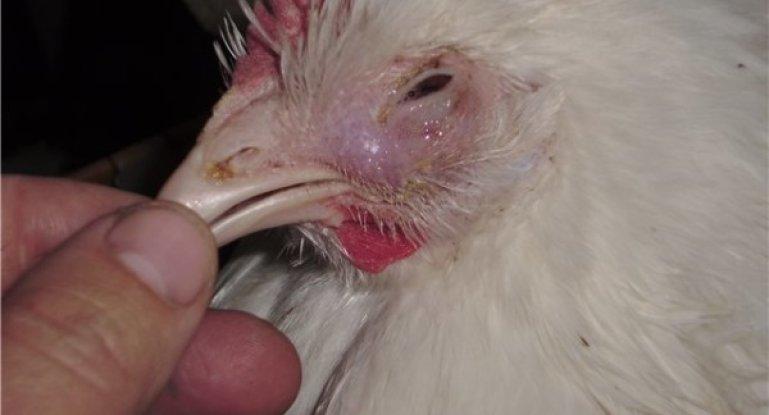
Pullorosis
This pathology affects adults and young individuals. The first symptom of the disease is diarrhea. Pathology spreads by airborne droplets. At first, it is acute, and then becomes chronic. The pathology is characterized by general weakness, decreased motor activity, yellow stools, and rapid breathing. Sick birds lose their appetite and are very thirsty. They can fall on their feet or back. For treatment, antibacterial drugs are used.
Diseases of an invasive nature
Invasive pathologies are caused by violation of the rules for keeping birds. There are many pathologies that differ in symptoms.
Knemidocosis
The pathology is caused by feather mites that live on the limbs. Chickens peck the habitat of parasites, which leads to the formation of a crust. For the treatment of the disease, the external use of Neocidon and Stomazan is indicated.
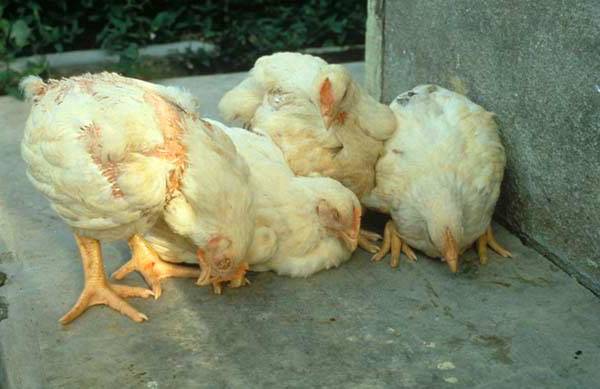
Pooferoids
These parasites lead to weight loss and the cessation of laying. Insects settle on the head, neck and abdomen. For the treatment of chicken, dry bathing is worthwhile. For this procedure, dust and ash are used.
Ascariasis
Pathology leads to the depletion of the chicken's body. The provoking factors are parasites that cause bloody discharge from the mouth and diarrhea. To cope with the disease, anthelmintics are used.
Heteracidosis
Pathology has no specific symptoms. It is provoked by nematodes. With this ailment, diarrhea, weight loss, and general weakness occur. To avoid the disease and cope with it, antihelminthic drugs are prescribed.

Coccidiosis
Parasites enter the body of chickens from feed, water, from sick individuals or rodents. Symptoms of the pathology resemble an intestinal infection. In this case, the chickens lose weight, and anemia occurs. For treatment, it is worth using sulfonamides or drugs from the nitrofuran series.
Fungal diseases
The reason for the development of such pathologies lies in the infection with fungal microorganisms. To cope with the problem, you need to make an accurate diagnosis.
Aspergillosis
This pathology occurs in weakened chickens due to a violation of the conditions of detention. In this case, the respiratory organs are affected. Birds experience symptoms of shortness of breath, hoarseness when breathing. In this case, the earrings and scallop acquire a blue color. Mucus can flow from the nose, feathers fall out, diarrhea occurs with blood. It is recommended to solder sick birds with a solution of copper sulfate and give them antifungal agents.
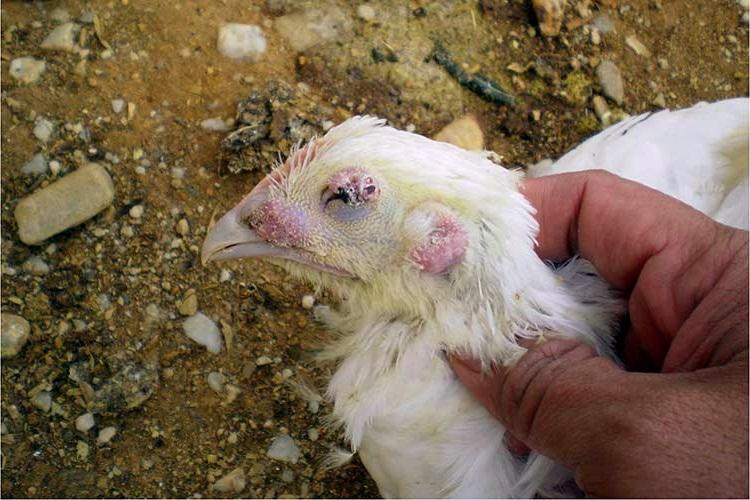
Ringworm
This is a dangerous pathology that affects adults. The disease is accompanied by loss of feathers and skin exposure. In this case, the earrings and scallop are covered with yellow spots. After that, the respiratory organs suffer, and the bird dies. There are no effective treatments.
External parasites
Chickens can be affected by parasites that live on their skin and feathers. This leads to severe itching and sores.
Scabies
Pathology is provoked by one of the varieties of the tick. Parasites cause brittleness and loss of feathers in chickens and roosters. They also provoke inflammation of feathers, anemia and pale skin, and a decrease in productivity. A pyrethroid emulsion is used to remove ticks.
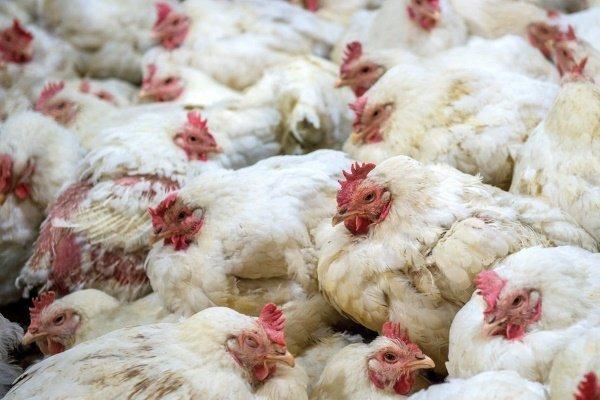
Bed bugs and fleas
These pests cause unpleasant sensations in chickens and spread dangerous diseases - plague and fever. They usually attack in the dark.At the same time, the birds are constantly itching, red wounds appear on their body, the appearance of feathers worsens.
Pooferoids
These parasites provoke the development of mallophagosis. They feed on feathers and dead skin particles. Chickens are infected through dirt or old feed. When infected, characteristic holes appear on the body of chickens, the weight of birds decreases, and their egg production worsens. It is quite difficult to cure the pathology. Most often, external drops are used - Bars or Frontline.
Chicken mite
These parasites spread dangerous diseases - cholera, borreliosis, plague. Infection occurs through moist litter. When infected, chickens shake their heads. Also, the hen shakes it in different directions. Due to the loss of blood, the crests and earrings become pale in color. Birds may die without treatment. Of insecticides, agents with permethrin are used.
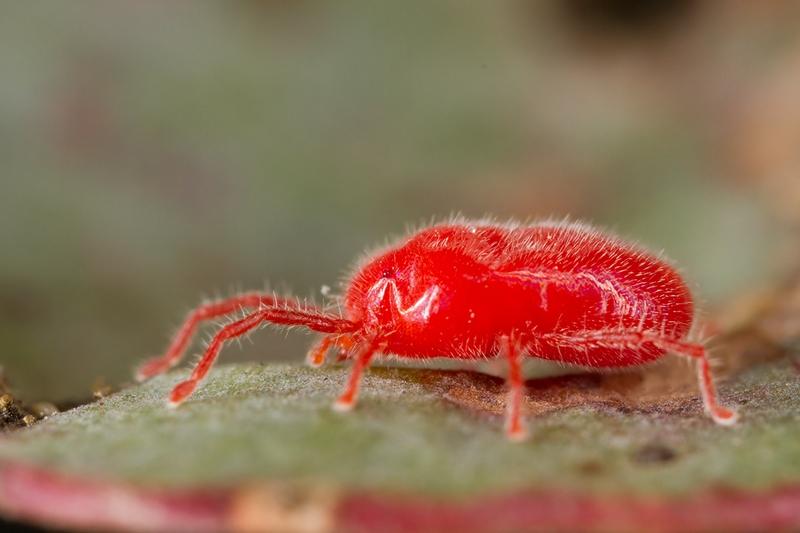
Sharp objects in the stomach
When keeping chickens free-range, they can peck small stones. With food, glasses, tough grass, and bones often get into the digestive organs.
Sharp objects cause damage to the gastric walls, resulting in inflammation and bleeding. As a result, the bird dies.
Sometimes pointed objects get stuck in the goiter, which causes damage to part of the esophagus and poses a threat to the life of the bird.
How do you know if a chicken is sick?
If chickens get sick, they have specific manifestations. Many pathologies are accompanied by an increase in body temperature. There is also a change in the parameters of the pulse and respiration.
In addition, the following manifestations occur:
- the chicken moves a little;
- a cloudy liquid flows from the nose and eyes;
- the bird has a drooping tail;
- the chicken is ruffled and stretches its neck;
- the bird hides and lowers its head;
- the chicken becomes lethargic and no longer moves;
- periodically opens the beak;
- stands with wings dangling.
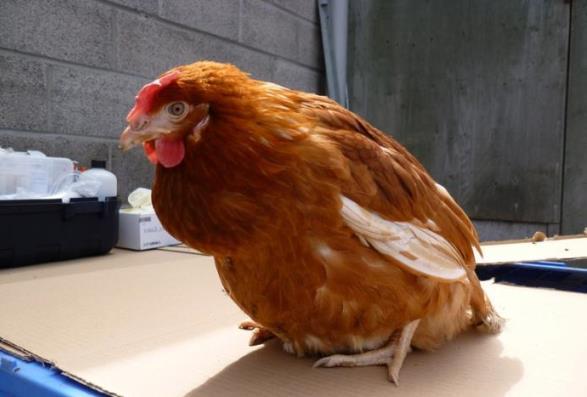
Prevention of chicken diseases
To prevent dangerous diseases from appearing in the household, prevention should be carried out:
- Every month, clean the chicken coop and disinfect the walls, feeders, equipment.
- Systematically treat cutaneous parasites and rodents in the house.
- Avoid contact of domestic chickens with wild birds.
- Keep new birds in quarantine for 1 month.
- Provide birds with optimal temperature parameters. They also need a balanced and varied diet.
- Provide chickens with sufficient walking area. It is important to avoid crowding. It is not recommended to keep birds of different ages together.
- If a disease is suspected, the bird should be isolated and a veterinarian should be consulted. The specialist will conduct diagnostic studies and select therapy.
- Observe your own safety measures. Some pathologies of chickens are dangerous to people, so you need to adhere to the rules of personal hygiene.
It is important to vaccinate in a timely manner, which helps protect birds from a variety of infections. Chickens are susceptible to a variety of infectious and parasitic infections. To avoid the development of pathologies, it is necessary to vaccinate birds in a timely manner and provide them with optimal conditions of detention. If infected birds are identified, they should be isolated and treatment immediately started.
